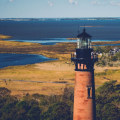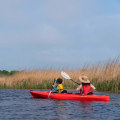Currituck County, located in the northeastern corner of North Carolina, is a paradise for nature lovers and outdoor enthusiasts. With its stunning beaches, quaint towns, and rich history, it's no surprise that this county has become a popular tourist destination. One of the must-visit attractions in Currituck County is the Currituck Banks Reserve, a 965-acre protected area that offers visitors a chance to explore the unspoiled beauty of the Outer Banks.
The History of Currituck Banks Reserve
The Currituck Banks Reserve was established in 1986 as part of the North Carolina Coastal Reserve and National Estuarine Research Reserve System. This system was created to protect and manage coastal areas for research, education, and stewardship purposes.The reserve is managed by the North Carolina Division of Coastal Management and is open to the public for recreational activities.The reserve is situated on the northern end of Bodie Island, which is part of the Outer Banks barrier islands. It stretches from the town of Duck to the Virginia state line and encompasses a variety of habitats such as maritime forests, marshes, dunes, and beaches. The reserve also includes a portion of the Currituck Sound, a shallow estuary that is home to a diverse array of plant and animal species.
Exploring the Reserve
Visitors to the Currituck Banks Reserve can experience its natural wonders through a variety of activities such as hiking, birdwatching, fishing, and kayaking. The reserve has several trails that wind through different habitats, offering visitors a chance to observe a variety of plants and animals.The most popular trail is the North Pond Trail, a 1.5-mile loop that takes visitors through a maritime forest and along the edge of the Currituck Sound.The reserve is also an ideal spot for birdwatchers, with over 200 species of birds recorded within its boundaries. The diverse habitats of the reserve provide a home for a variety of birds, including waterfowl, shorebirds, and raptors. The best time to spot these feathered creatures is during the spring and fall migration seasons.Fishing is another popular activity at the Currituck Banks Reserve. The Currituck Sound is known for its abundant fish population, including striped bass, flounder, and bluefish.
Visitors can fish from the shore or launch a kayak or canoe to explore the sound's many creeks and channels.
Preserving the Natural Beauty
The Currituck Banks Reserve is not only a popular tourist attraction but also an important area for conservation. The reserve's diverse habitats provide a home for many rare and endangered species, including the loggerhead sea turtle, piping plover, and American black bear. The reserve also serves as a vital stopover for migratory birds on their journey along the Atlantic Flyway.To protect these species and their habitats, the reserve has implemented several management strategies such as controlling invasive species, monitoring water quality, and conducting research on wildlife populations. Visitors are encouraged to follow Leave No Trace principles when exploring the reserve to help preserve its natural beauty for future generations.Planning Your Visit
The Currituck Banks Reserve is open year-round from sunrise to sunset.There is no entrance fee, but visitors are required to obtain a free permit before entering the reserve. Permits can be obtained online or at the reserve's visitor center located in Corolla. The visitor center also offers educational exhibits and programs about the reserve's natural and cultural history.When planning your visit to the Currituck Banks Reserve, keep in mind that it is a natural area and does not have any facilities such as restrooms or food vendors. Visitors are advised to bring plenty of water, snacks, and sunscreen.
Pets are not allowed in the reserve to protect the wildlife, so make sure to leave your furry friends at home.



